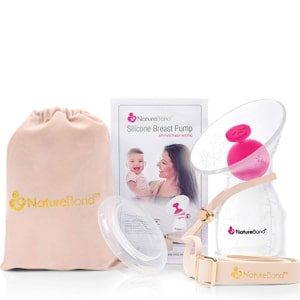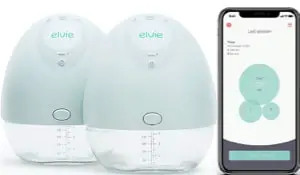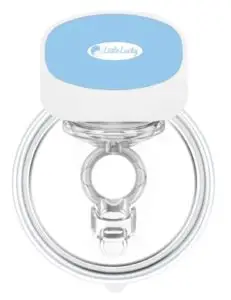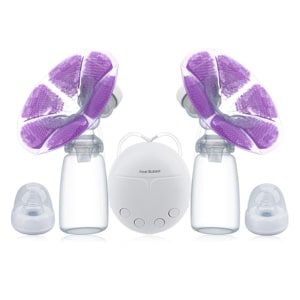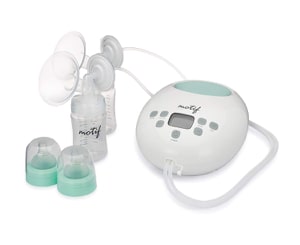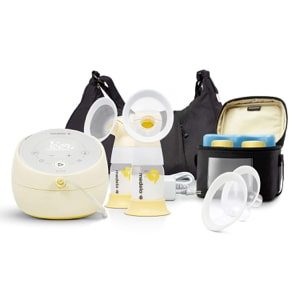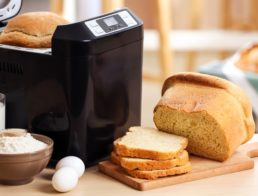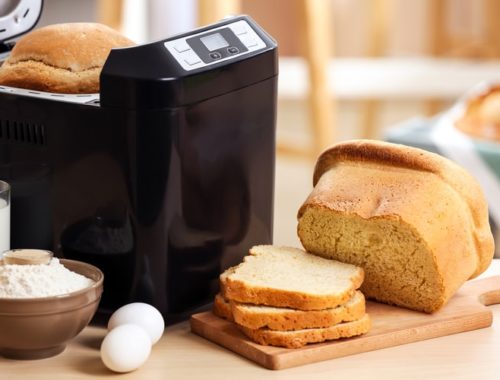As a mom, you’re probably familiar with the benefits of breastfeeding. The American Academy of Pediatrics (AAP) states that it protects against a variety of diseases and conditions in infants including respiratory tract infections, type 1 and type 2 diabetes, and childhood overweight and obesity.1
The U.S. Department of Health & Human Services adds that breastfed babies have a lower risk of asthma, childhood leukemia, ear infections, and eczema. There are also benefits for moms, including decreased postpartum bleeding, reduced risk of breast and ovarian cancers, and an earlier return to prepregnancy weight.2 Breastfeeding provides a unique bonding experience between mom and baby, as well, and is often a cherished time for many mothers.
Still, you’re a busy woman and there will likely be times when you can’t be with your baby for feedings. This is where a breast pump can come in handy. It allows you to go back to work, run errands, or enjoy a date night with your partner while still giving your baby the benefits of mother’s milk. Pumping also allows your partner to bond with baby during feedings while providing opportunities for other members of the family—like siblings, grandparents, and aunts and uncles—to enjoy feeding. Mothers who struggle with not enough or too much milk can often solve these problems with a breast pump, while those with babies who aren’t nursing well can maintain milk supply.
If you’re sold on getting a breast pump, don’t be surprised if you feel overwhelmed when shopping for one. There are lots of them out there, which can leave you confused about which is best. We recently reviewed dozens of breast pumps, looking at speed of pumping, single- or double-breasted models, manual or electric, hands-free options, degree of suction, and cost. All of these top-rated breast pumps can be purchased online at Amazon.
We’ve identified the Bellababy Double Electric Breast Feeding Pump as our best overall pick. It is a safe and sanitary closed-system pump with four sucking modes and nine levels of suction, plus it has a 2200mAh lithium-ion battery for ease of portability.
In This Article
The 5 Top-Rated Breast Pumps
| Editor's Picks | Brand | Rating |
|---|---|---|
| Best Breast Pump Overall | Bellababy Double Electric Breast Feeding Pump | 4.3 |
| Best Portable Breast Pump | New Medela Portable Breast Pump | 4.6 |
| Best Budget Breast Pump | Bumblebee Manual Breast Pump | 4.5 |
| Best Wearable Breast Pump | Elvie Wearable Breast Pump | 3.9 |
| Best Hospital Grade Breast Pump | Spectra Baby USA S1Plus | 4.7 |
*Ratings are from Amazon at the time of publication and can change.
Best Breast Pump Overall: Bellababy Double Electric Breast Feeding Pump
This daily use, double-breasted pump is designed for moms who pump several times a day. Portable and convenient, the Bellababy Double Electric Breast Feeding Pump can be taken anywhere as it has a large capacity built-in battery for on-the-go use. That battery is USB rechargeable, and powers a sharp LED display that operates wirelessly, so you never have to plug it in while using it.
On the sensitive-touch display, you’ll find readouts for suck mode, time, battery status, suck level, and massage mode. You can set the unit to massage and stimulate the breasts before pumping, which makes the process more comfortable and pain-free. The four working modes include massage (6 levels), continuous suck (6 levels), normal suck (9 levels), and frequency conversion (9 levels) suck.
The unit also comes with two milk storage bag adaptors and 10 storage bags that are BPA- and phthalate-free. The closed-system pump ensures a sanitary operation, while the flanges are made of soft liquid silicone to reduce pain during sucking.
Reviewers love the power of this little pump along with the reasonable price and say its compact size makes it easily portable.
Bellababy Double Electric Breast Feeding Pump Key Features:
- Closed system ensures sanitary operation
- Double pump works on both breasts at the same time
- Massages and stimulates breasts before pumping
- Multiple levels of pumping ensure comfort
- Perfect for daily use and easily portable with battery operation
Best Portable Breast Pump: New Medela Portable Breast Pump
Our runner up is the handy New Medela Portable Breast Pump. Like our top pick, it’s also easy to pack up and take with you and even comes with a stylish cooler/travel bag. It’s a little more expensive, probably due to the Medela brand and the hospital-performance motor. Medela breastfeeding products are designed with the help of hospitals and lactation experts to provide highly efficient and sanitary results.
This hardworking pump is designed for busy moms who are likely to use it daily. The New MaxFlow advanced motor generates vacuum with micro-vibrations for effective breast milk expression, mimicking baby’s natural sucking rhythms. The closed system with overflow protection prevents milk from entering the tubing and/or motor, protecting the pump for long-lasting reliability.
The system comes with two sizes of PersonalFit Flex breast shields. Each has a soft rim and oval shape for enhanced fit and comfortable pumping. The manufacturer claims the pump is clinically proven to increase milk volume by nearly 12 percent, so if you’re struggling to produce the milk you need, this may be the pump for you.
You’ll find everything you need with this system, including a cooler bag, stylish pump bag, and convenient battery pack for mobile pumping. The pump itself has few parts to clean and assemble, with preprogrammed speed and vacuum settings.
New Medela Portable Breast Pump Key Features:
- Hospital-performance closed system pump
- Perfect for on-the-go moms who need to pump daily
- Comes with battery pack for on-the-go portability
- Includes a cooler bag and stylish pump bag
- Easy to clean and assemble
Best Budget Breast Pump: Bumblebee Manual Breast Pump
Most manual pumps are quite a bit cheaper than electric pumps, so it makes sense that our budget pick is a manual option. The Bumblebee Manual Breast Pump costs you only about $13, and in addition to the touchably soft pump, you also get a silicone bottle stopper, anti-dust lid, and a cute carrying bag.
Though electric pumps may be easier and more powerful, manual pumps like this one are super convenient, portable, and easy to clean. Since you use your hands to provide the suction, you control the pressure, which may make this even more comfortable for you. Simply squeeze the bottom of the pump in a shallow manner for gentle suction, or squeeze more aggressively for stronger suction. Then store your milk in the convenient bottle with the stopper or lid on top.
The product is small, lightweight, and portable; accommodates different breast sizes; and is soft, comfortable, and safe. The plastic is free of BPA, PVC, and phthalates, and can be placed in dishwashers, microwaves, boiling water, and sterilizers.
Reviewers love the simplicity of this pump, noting that it’s easy to use and clean.
Bumblebee Manual Breast Pump Key Features:
- Portable pump at an economical price
- Simple to use and clean
- Comes with a bottle stopper, anti-dust lid, and carrying bag
- Accommodates different breast sizes
- Safe for use in dishwashers, microwaves, and boiling water
Best Wearable Breast Pump: Elvie Wearable Breast Pump
For the die-hard multitasking mom, this Elvie Wearable Breast Pump may be a lifesaver. It’s small, quiet, and light, which makes it possible for you to pump on your own terms—at home, work, or on the go. Simply attach it to your breast, then go about your business, whatever that may be at the time. There are no external cords or tubes to worry about, and it comes with two included breast shields so you can find the right fit.
The Elvie is designed to be worn inside a standard nursing bra, so it’s truly hands-free. You can also connect it to a free app on your cell phone so you can monitor your milk volume in real-time, track your pumping history, and control the pump remotely. (Elvie will work with or without the app, so it’s completely up to you.) The automatic sensors automatically switch from stimulation into expression when the unit detects let-down and will pause when the bottle is full.
If you’re worried about being discreet, don’t be, as the motor is designed with a revolutionary technology that eliminates noise. It operates in stealth mode so you can pump in peace no matter where you are, with seven sucking intensity settings. The battery is rechargeable via micro-USB, and the reusable bottles are made with BPA-free, dishwasher-safe plastic.
Reviewers love that they can wear this pump while doing laundry, house cleaning, and babywearing, and note that it is very quiet when compared to other pumps.
Elvie Wearable Breast Pump Key Features:
- Hands-free design allows you to do other things while pumping
- Revolutionary technology eliminates noise
- Comes with seven sucking intensity settings
- Connect to the cell phone app to monitor milk volume in real-time and operate remotely
- Automatically detects let-down and switches from stimulation to expression
Best Hospital Grade Breast Pump: Spectra Baby USA S1Plus
If you need a breast pump to solve nursing issues or address health issues, try the Spectra Baby USA S1Plus. The hospital-grade pump extracts milk quickly and efficiently with as little discomfort as possible, which can help stimulate your body to make the milk you need for baby.
Portable and rechargeable, the Spectra is quiet and discreet and weighs only three pounds. When in the massage mode, it stimulates the natural suckling of baby, helping you to let-down so the milk can be expressed easily. A closed-system features backflow protection to keep your breast milk free of harmful bacteria.
You can customize your pump settings to your own body’s response, plus set the auto-timer and suction levels to your preferences. The unit has a soft blue night light which helps you pump at any hour, and includes two wide-neck bottles, two backflow protectors, and four flanges.
Reviewers love the comfortable, portable, and lightweight design of this pump, and note that it helped them increase their milk supply.
Spectra Baby USA S1Plus Key Features:
- Hospital-grade pump extracts milk quickly and efficiently
- Portable and rechargeable; weighs only about 3 pounds
- Quiet and discreet
- Closed system protects milk from bacteria
- Customizable settings and soft night light
Who Should Buy a Breast Pump
Though a breast pump can give you the freedom to do the other things you need to do in your life, that isn’t the only reason to get one. You may need a breast pump for other reasons.
If you’re producing more milk than your baby needs, for instance, you can drain the extra milk by using a breast pump. Pumping can help if you’re not producing enough milk as well, as it can stimulate lactation. It’s the perfect solution if your baby is too premature or sick to be breastfed in the hospital, and can help you heal if you develop mastitis. If your baby is having latching issues, pumping can help soften the nipples for easier latching.
Of course, breast pumps can be a lifesaver for women who need to return to work or be away from their babies for other reasons. It gives you the freedom to go back to work if you need to while allowing others in the family to experience the joy of feeding baby. Pumping also helps you avoid the expense of using formula, and will relieve pressure and pain when you begin to wean your baby.
Finally, no mom would argue that caring for an infant can be exhausting. Having a bottle of expressed milk available allows you to take a break when needed to spend some quality time by yourself. Making sure you are rested and healthy is one of the best things you can do for your baby.
Important Features to Consider
When shopping for a breast pump, consider the following features:
- Frequency of use. How often will you be using your breast pump? This is an important question because the more you’re going to pump, the more reliable your pump needs to be. Manual pumps and smaller motorized pumps are best for occasional use, whereas larger electric pumps are usually a better choice for women who need a dependable and efficient pump for frequent use.
- Open- or closed-system. You may have seen breast pumps described as “open system” or “closed system.” These terms refer to whether there is a barrier between the breast pump and your expressed breast milk. A pump with a barrier is known as a “closed system” as it is “closed off” from the milk, preventing overflowing and leaking into the pump mechanism. This prevents contamination between the pump and the milk, keeping the pump clean and ensuring the milk travels through a sanitary system. An open system doesn’t have a milk barrier. Though risks of contamination are still small, it’s important to clean the tubing and ensure it’s completely dried out after each use. If milk is left inside the tubing, it can grow mold that may then transfer to the motor of the pump, which can’t be cleaned.
- Health issues. If you need to get a pump because your baby is premature, you’re too sick to nurse, or you and your baby are having difficulty nursing for other reasons, you may need a hospital-grade pump. These are also helpful for mothers who have had breast reduction surgery, have medical conditions like untreated low thyroid levels, or who are inducing lactation for an adopted baby.
- Speed of pumping. How fast do you need the pump to operate? A typical pumping session, according to the Mayo Clinic, lasts 10-15 minutes per breast.3 If you’re pumping at work or during other time-crunched situations, you may need something faster. A double-breast pump can help reduce pumping time by half.
- Hands-free. More advanced breast pumps allow you to express your milk while leaving your hands free to do other things. If you’re raising multiple children, for example, or multi-tasking for other reasons, this type of pump can be super convenient. There are also wearable pumps that can be placed inside your bra for discreet pumping.
- Suction adjustable. Some breast pumps allow you to adjust the degree of suction and cycling speed. This may be important to you if you’re pumping for the first time, or if you’re struggling with lactation for various reasons. Adjustable breast pumps can also make pumping more comfortable for you.
- Ease of use. Some breast pumps are easier to assemble, clean, and transport than others. If you’ll be using yours exclusively at home, you probably don’t have to worry about this too much, but if you’re going to be on the road or heading to work every day, having a lightweight model—perhaps even one with a carrying case—may be the best option.
- Noise level. Some pumps are louder than others. Will you be using yours in a public place? If so, you may want to look for models that run quietly.
- Power options. A manual breast pump will work even if the power goes out. Some electric versions may also have rechargeable battery packs, which can be helpful during emergency power outages.
Frequently Asked Questions
How does a breast pump work?
Breast pumps are made up of the following essential components:
- Breast shield: Also called a “flange,” this is the breast “cup” that you put on your breast. They come in various sizes, with some pumps providing several different ones to be sure you find the right fit.
- Milk container: This is the bottle or bag in which the milk goes for collection.
- Power source: On manual pumps, this is the handle. On electric pumps, it is the motor.
When you use the pump, the flange sits over the nipple to create a seal. Then through your manual efforts or the work of the electric motor, air is pulled into the breast shield and the nipple is drawn into the tunnel. This triggers the “let-down” of the milk. The pump then creates a suction and release process that draws milk out of the breast and transfers it into the container.
What kind of breast pumps are there?
In general, there are four types of breast pumps:
- Hospital-grade breast pumps: These are heavy-duty pumps with powerful motors that create a greater amount of “sucks” per minute. They work quickly and can help with various nursing problems, but they are expensive and bulky. Women who need them usually rent them for a short time until they have solved the issue.
- Electric breast pumps: These are popular because they’re easy and fast to use. They require electricity to function, but some come with rechargeable batteries, which make them more portable. Many also have carrying cases and coolers for milk transport. Both single- and double-breasted options are available.
- Wearable electric breast pumps: These are newer to the market, but they have gained popularity because of their convenience. You wear pump cups in your bra, which allows you to pump discreetly and in varying positions no matter where you are or what you may be doing.
- Manual breast pumps: These do not use electric power. Rather, you use the power in your hands to create suction and pump the milk. These don’t work as efficiently or as fast as their electric counterparts, but they are quiet and often work perfectly for occasional pumping or use while traveling. They are also inexpensive.
Is pumping bad for your breasts?
Breast pumps, though they can provide several benefits, may sometimes create uncomfortable side effects.
- Nipple and breast tissue damage: This can occur if the breast pump setting is too high or too slow, or if the pump flanges are not the right size. These problems can also cause pain while pumping. You can avoid this side effect by making sure to select the right speed and flange size. You can tell the size is incorrect if your nipple rubs the sides with suction, a large part of the areola is pulled into the tunnel with suction, or you notice redness after pumping. It also helps to apply a safe and non-toxic moisturizer to your breasts after pumping to help protect the skin.
- Breast engorgement: If you pump a lot of milk to store later, you could encourage your body to produce more, which can lead to breast engorgement. You can avoid this side effect by pumping regularly, but expressing only the amount you need at any one time.
- Decreased milk supply: Just as using the pump too much can lead to excessive milk supply, a breast pump may also lead to a drop in milk supply. When a baby latches on, he or she stimulates your body to produce more milk. A pump doesn’t work quite the same way, and over time, may lead to lower milk supplies. You can reduce your risk of this side effect by double pumping (rather than pumping only on one side), increasing your frequency of feeding or pumping, and pumping after feeding if you have milk remaining.
Other Breast Pumps We Reviewed
We looked at 20 other breast pumps. Even though they didn’t make our five best breast pumps list, they’re the best of the rest and each is still a great option for expressing milk when you can’t feed. The information you’ll need to compare each one is included with the listing.
- Electric Breast Pumps
- Portable Breast Pumps
- Manual Breast Pumps
- Wearable Breast Pumps
- Hospital Grade Breast Pumps
Electric Breast Pumps
Philips Avent Double Electric Breast Pump
Choose from three expression settings (low, medium, high) on this pump, which includes a unique no-lean-forward design meant to make pumping more comfortable.
Key Features:
- Quiet, efficient pump
- Includes soft massage cushion with comfort petals
- Allows double pumping for efficient expression
- Easy setup and cleaning
Cost: $160
Medela Swing Single Electric Breast Pump
This single breast pump can easily fit inside your purse, backpack, or tote bag. The unique Medela pump technology allows you to pump more milk in less time, with easy-to-use controls.
Key Features:
- Compact enough to fit in your purse or tote bag
- Operate with the AC power adaptor or use 4 AA batteries (not included)
- Designed for moms who pump occasionally
- Comes with a belt clip and neck/shoulder strap
Cost: $110
Portable Breast Pumps
Eccomum Electric Double Breast Pump
Pump both breasts at the same time with this highly adjustable, closed-system pump. Comes with nine suction levels and a full touchscreen LED display.
Key Features:
- Ultra-quiet design
- Portable with a large-capacity battery
- Perfect for travel or work
- Easy to clean
Cost: $49
Aweso 4U Double Electric Breast Pump
This dual suction breast pump comes with a full touchscreen display that’s easy to operate. Adjust the mode and memory as you wish, and choose from 16 different suction levels.
Key Features:
- Made of medical-grade silicone material, BPA-free
- Highly efficient and customizable
- 16 different suction levels
- Built-in 1200 mAh rechargeable battery
Cost: $40
IKARE Double Electric Breast Pump
IKARE makes a strong, closed-system pump with five modes and nine levels of suction to choose from. The feeding pump works at a low noise level, and it has a large capacity built-in USB-rechargeable lithium battery that gives you three hours of life between charges.
Key Features:
- Customizable with five modes and nine suction levels
- Quiet operation
- Built-in battery provides three hours of use between charges
- Comes with a high-definition screen
Cost: $55
BabyBuddha Portable Breast Pump
Head out to run your errands or go to work with this small and convenient double breast pump. The quiet mechanism allows for discreet pumping while the closed system ensures milk doesn’t become contaminated.
Key Features:
- Small and quiet
- Simple to use with trackball operator you can hang around your neck with the included lanyard
- Battery-powered pump can be charged with any standard USB cable port
- Comes with 14 different comfort settings
Cost: $200
Momcozy Double Electric Breast Pump
Lightweight and portable, this wireless pump can be used for 1.5 hours after being fully charged. Provides two modes (massage and pumping) and nine suction levels.
Key Features:
- Closed system pump with backflow protector valve
- Contains two extra-long anti-overflow milk bag clips with two food-grade pacifiers and feeding bottles
- Physical keys offer longer life than touch-screen designs
- Can be used as a single or double pump
Cost: $57
Yihunion Portable Electric Breast Pump
Operate this pump with one hand! It’s small and easy to carry around and provides an eight-level massage mode to help improve lactation. Features a hygienic closed-system design to keep milk fresh.
Key Features:
- Includes 900 mAh rechargeable lithium battery
- Small and convenient for taking with you
- No wires to mess with
- Includes an extra function specially designed for new mothers
Cost: $49
Manual Breast Pumps
This is a popular manual breast pump recommended by nursing moms and lactation consultants. Forget pricy electric pumps and use the power of natural suction to express your milk.
Key Features:
- Simple and inexpensive
- Award-winning and recommended by nursing moms
- Lightweight and portable; perfect for every baby bag
- Designed to fit all sizes of breasts
Cost: $13
If you’re not sure of your manual pumping technique, you may like this option from Philips as it has a trigger handle on it. The soft textured massage cushion helps stimulate milk flow.
Key Features:
- “No-lean-forward” unique design
- Comfortable massage cushion
- Convenient pumping handle
- Comes with a natural bottle
Cost: $26
Like the Philips, this lightweight manual pump also comes with an ergonomic, easy-express handle to reduce hand fatigue, as well as two flange sizes NaturalWave nipple, cap, and collar.
Key Features:
- Ergonomic, easy-express handle reduces hand fatigue
- Pump directly into the pre-sterilized milk storage bags and bottles
- Carry it in your bag or purse while traveling
- Two-mode technology for stimulation and expression
Cost: $17
Get more value for your money with this manual pump, which comes with an innovative safety pump strap, silicone pump stopper, dust cover lid, and velvet pouch. Collects “let-down” leaks and relieves engorgement using natural suction pressure.
Key Features:
- Comes with a pump strap and stopper
- Extremely soft and comfortable
- Can be used hands-free during breastfeeding to save breastmilk on the other side
- Makes a great gift for new moms
Cost: $13
Enjoy this two-for-one deal: two manual pumps for the price of one. They’re both lightweight and travel-friendly, easy to clean, and made with 100 percent food-grade, BPA-free silicone.
Key Features:
- Two-for-one deal
- Effective but simple design
- Easy to clean with mild soap and warm water
- No battery or assembly required
Cost: $11
Wearable Breast Pumps
This pump is just like our top pick in wearable pumps, except that it’s a double rather than a single pump. That makes it more expensive, but if you’re truly pressed for time, you may prefer this option.
Key Features:
- Hands-free design allows you to pump anytime, anywhere
- Discreet and quiet; small and lightweight
- Connect to the free Elvie Pump app to monitor milk volume in real-time
- Easy to assemble and clean
Cost: $500
Little Lucky Wearable Breast Pump
If you’re on a budget but still want a wearable pump, try this one. It’s only $60, but it still offers hands-free operation. Though not as sleek as the Elvie, it’s perfect for use around the house while you’re cleaning or cooking.
Key Features:
- Wearable and hands-free
- Hygienic, closed system prevents milk from flowing back into the pumping unit
- Five adjustable suction levels
- Milk flows into the spill-proof storage container
Cost: $60
KidsTime Hands-Free Breast Pump
This option is bulkier than the other two, so it’s not something you can wear at work, but it is made to operate hands-free, allowing you to do other things while you’re at home. Pump both breasts at the same time, with 18 different modes to choose from.
Key Features:
- Hands-free design perfect for multi-tasking moms
- 18 different modes to choose from
- Double-breast design allows for faster pumping
- Rechargeable battery; low noise
Cost: $30
Hospital Grade Breast Pumps
Like our top pick above, this Spectra also has a hospital-grade, closed-system motor and customizable settings. It’s a little less expensive, though, yet it still comes with a quiet motor and adjustable suction levels.
Key Features:
- Hospital-grade, closed-system pump
- Customizable settings
- Quiet operation
- Soft night light
Cost: $160
Motif Medical Luna Double Electric Breast Pump
Sophisticated, strong, and soothing, the Motif Medical Luna helps you get more milk in less time. The built-in LED night light is customizable with three different settings, and the unit weighs only two pounds.
Key Features:
- Hospital-grade, closed-system pump
- Comes with a built-in LED night light
- Research-based pump showed in a clinical study to help moms get more milk in less time
- Offers a single or double pumping option
Cost: $190
Ameda MYA Hospital Strength Breast Pump
Mya’s closed system pump helps prevent milk from backing up into the tubing and pump, keeping it free of contaminants. Personalize each pumping session with a two-phase adjustable suction mode with 10 unique levels of expression mode and five levels of massage mode.
Key Features:
- Hospital-grade, closed-system pump
- Customize each pumping session with multiple choices
- Comes with a large tote bag, two 24mm flanges and two 28mm flanges, extra valves, and AC power adapter
- Has a rechargeable battery so you can use it on the go
Cost: $237
Medela Sonata Smart Breast Pump
Inspired by the Medlea Symphony hospital-grade pump, this research-based was designed for optimal efficiency and maximized flow. Includes a rechargeable battery.
Key Features:
- Hospital-grade, closed-system pump
- Connect to the MyMedela app for streamlined and personalized tracking
- Comes with a carry bag, one set of 21 mm & 24 mm PersonalFit Flex breast shields, two breast shield connectors, four 5-ounce bottles & lids, cooler & ice pack, two bottle stands, and power adapter
- Has a rechargeable battery so you can use it on the go
Cost: $250
- Benefits of Breastfeeding. AAP.org. https://www.aap.org/en-us/advocacy-and-policy/aap-health-initiatives/Breastfeeding/Pages/Benefits-of-Breastfeeding.aspx. Accessed October 29, 2020.
- Making the decision to breastfeed. WomensHealth.gov. https://www.womenshealth.gov/breastfeeding/making-decision-breastfeed. Published 2019. Updated March 14, 2019. Accessed October 29, 2020.
- What’s the right breast pump for you?. MayoClinic.org. https://www.mayoclinic.org/healthy-lifestyle/infant-and-toddler-health/in-depth/breast-feeding/art-20046850. Published 2020. Accessed October 29, 2020.

















